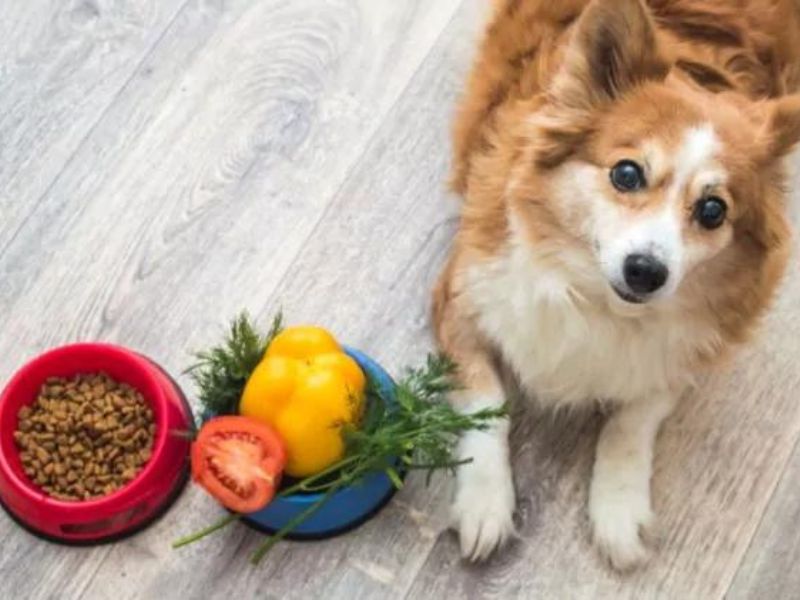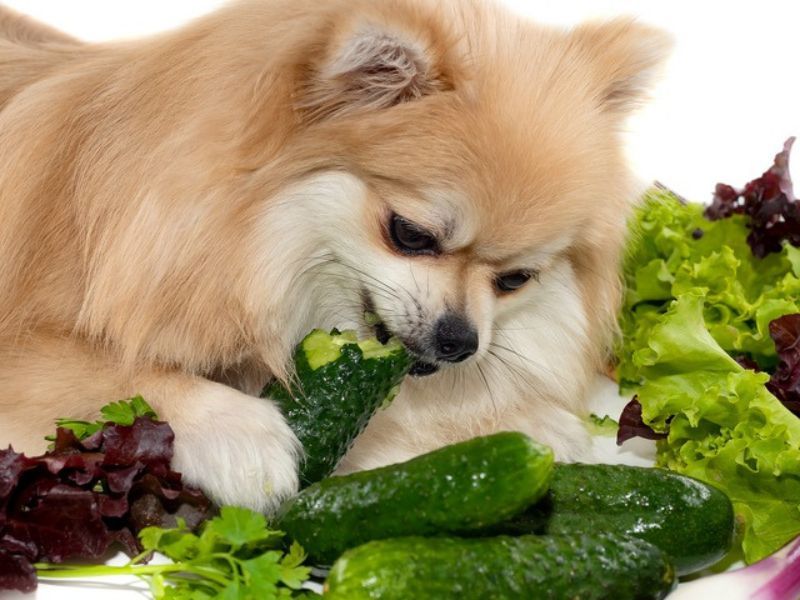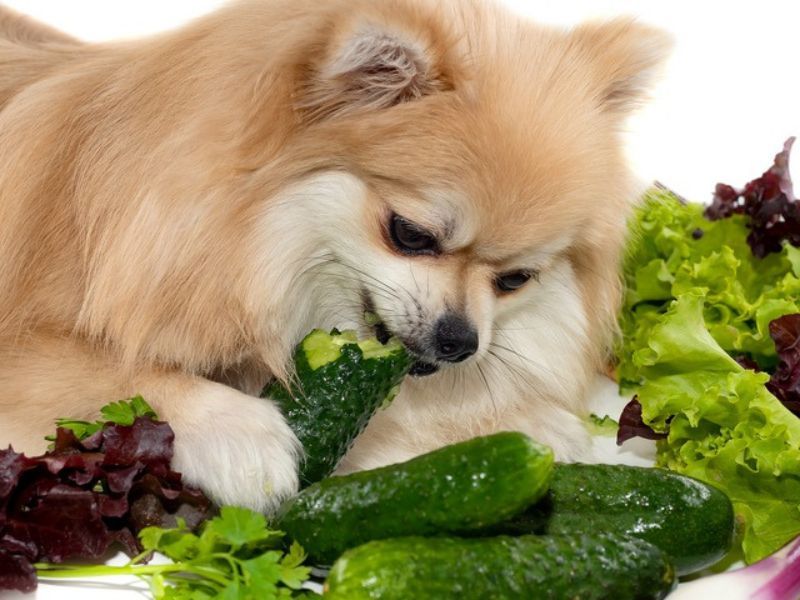
Getting dogs to eat their vegetables can be a challenge since dogs are naturally carnivorous and may not be inclined to eat plant-based foods. While dogs naturally prefer meat, adding veggies to their diet can boost their health. It takes patience, creativity, and some cooking tricks to make it happen.
Remember that not all vegetables are safe for dogs, so it’s essential to research which ones are safe and appropriate for your pet. Always monitor your dog’s reaction to new foods and discontinue any that cause digestive upset or other adverse reactions.
We’ll explore different ways to make vegetables appealing to dogs, whether by mixing them into meals or turning them into tasty treats. Through this journey, we’ll learn how to make veggies a yummy and essential part of our dogs’ diet as well as meet our dogs’ nutritional needs while strengthening our bond with them.
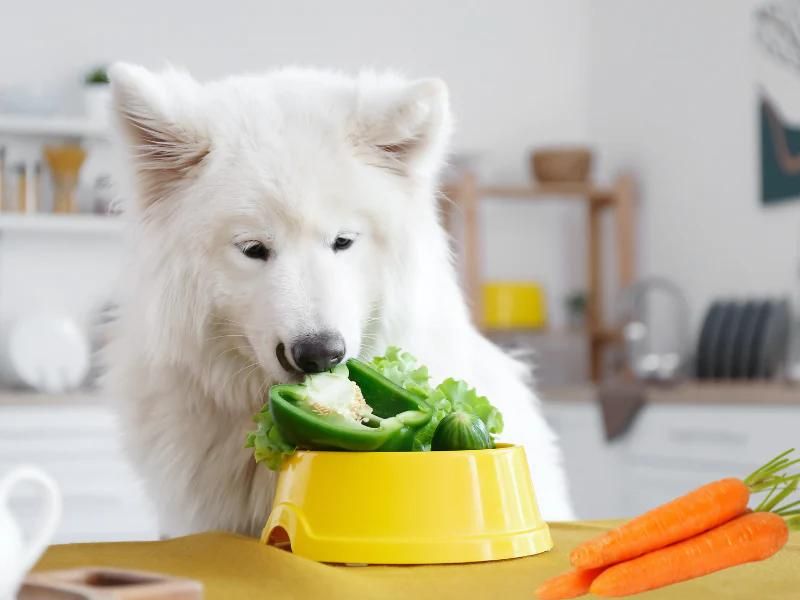
Should Dogs have Vegetables in their Diet?
While dogs are primarily Omnivores, incorporating vegetables into their meals can provide essential vitamins, minerals, antioxidants, and fiber that contribute to overall health. Vegetables can also serve as a source of hydration and help with weight management by adding bulk to their meals without excess calories.
However, it’s essential to ensure that any vegetables given to dogs are safe and appropriate for their digestive systems. Some vegetables, such as onions, garlic, and certain types of mushrooms, can be toxic to dogs and should be avoided. Vegetables should be prepared in a way that makes them easy for dogs to digest, such as being cooked, pureed, or finely chopped.
As with any dietary changes, it’s recommended to consult with a veterinarian to determine the specific nutritional needs of your dog and to ensure that any additions to their diet are appropriate and balanced. By incorporating vegetables into their diet in moderation and under veterinary guidance, you can help support your dog’s overall health and well-being.
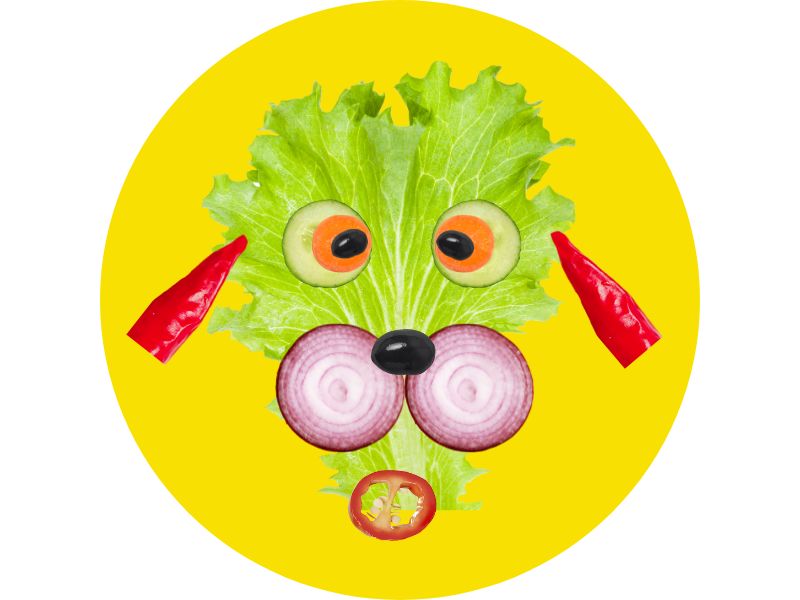
Incorporating vegetables into a dog’s diet offers numerous benefits, such as:
- Vegetables provide essential vitamins, minerals, and antioxidants that support overall health, including immune function and skin health.
- Vegetables contain fiber that aids in digestion, promotes gut health, and can help manage weight by providing a sense of fullness without excess calories.
- Certain vegetables with high water content contribute to hydration.
- Crunchy vegetables can improve dental health by reducing plaque buildup.
- Including vegetables adds variety to meals, making them more enjoyable and preventing dietary monotony.
- Vegetables offer a natural source of nutrients that complement a dog’s diet, supporting their dietary needs and promoting balanced nutrition.
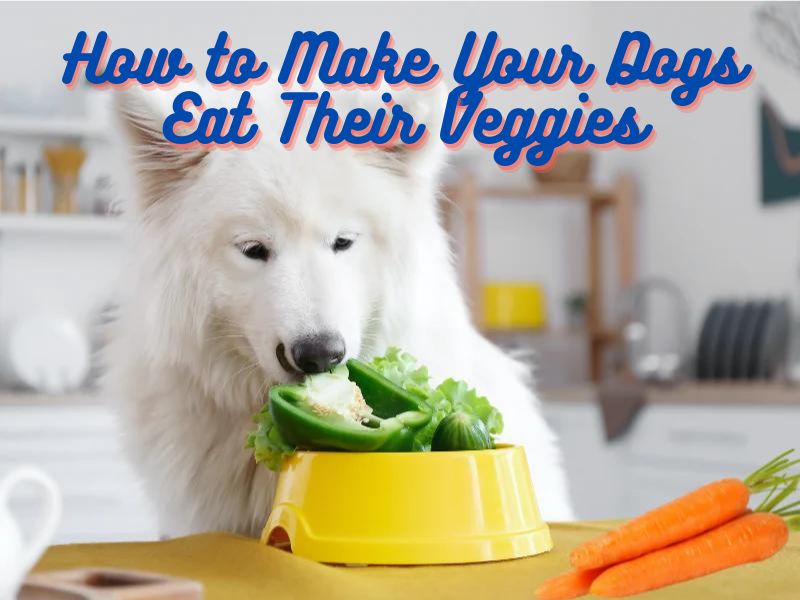
How to Make Your Dog Eat Their Veggies
Are you struggling to get your dog to eat their vegetables? Yes, it indeed can take patience, creativity, and some cooking tricks to make your dog eats vegetables.
But don’t be afraid, we are going to give you effective yet simple strategies that will have your dog happily munching on their greens in no time. Say goodbye to mealtime battles and hello to a happier, healthier pup!
1. Lead by Example
2. Don’t Offer an Alternative (just yet!)
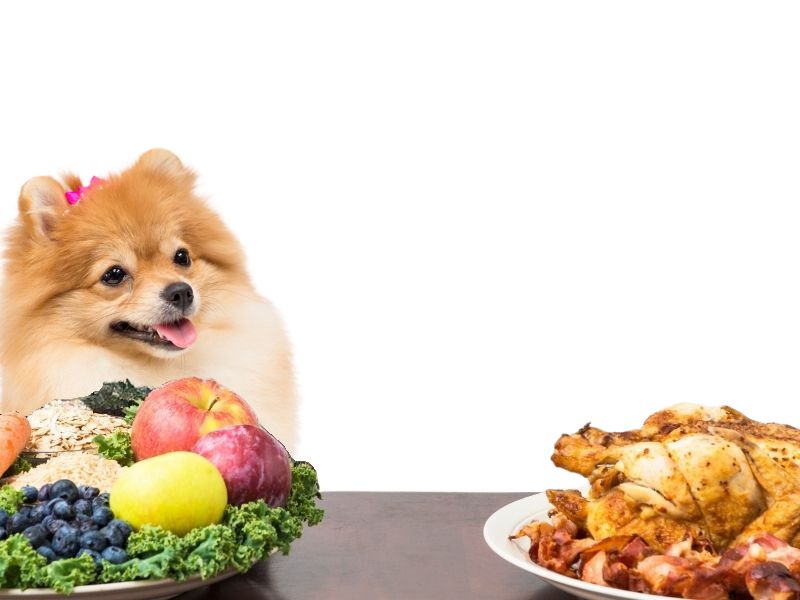
Present your dog’s meal with vegetables included alongside their regular food. Resist the temptation to offer alternative options or remove the vegetables if your dog shows reluctance. Instead, provide encouragement and positive reinforcement as they explore the meal.
If your dog initially refuses to eat the vegetables, remain patient and avoid offering alternative foods immediately. Dogs may be resistant to change at first, but consistency and perseverance can gradually shift their attitude towards vegetables.
Over time, as your dog becomes more accustomed to seeing vegetables in their meals, they may begin to show interest in trying them. Continue to offer praise and rewards when they do so, reinforcing the positive behavior.
Once your dog consistently eats their meals with vegetables without hesitation, you can gradually introduce alternative options if desired. However, always prioritize the inclusion of vegetables in their diet to maintain their newfound acceptance and enjoyment of these nutritious additions.
3. Add Some Peanut Butter
Peanut butter’s rich and savory taste can mask the sometimes bland or unfamiliar flavors of vegetables, making them more appealing to dogs.
You can slice or chop the vegetables into bite-sized pieces suitable for your dog’s size and preferences. Then, apply a small amount of peanut butter to the vegetables, either by spreading it on or using it as a dip. Be mindful of the amount of peanut butter used, as it should be a flavorful addition rather than overpowering the vegetable entirely.
Give the peanut butter-coated vegetables to your dog during mealtime or as a snack. The enticing aroma and familiar taste of peanut butter are likely to pique your dog’s interest and encourage them to give the vegetables a try.
As your dog begins to associate the delicious flavor of peanut butter with the vegetables, gradually reduce the amount of peanut butter used or offer the vegetables without it. With time, your dog may develop a taste for the vegetables themselves, even without the added incentive of peanut butter.
Remember to monitor your dog’s intake of peanut butter, as it is high in fat and calories. Use it sparingly and opt for natural, unsweetened varieties without added salt or xylitol, which can be harmful to dogs.
4. Food Dehydrator to Make Great Chewy Treats!
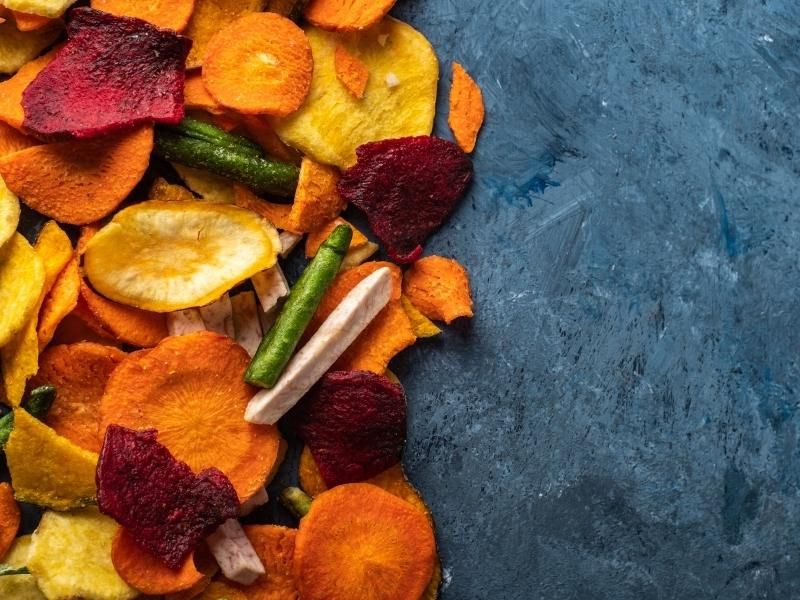
By using a food dehydrator to create fantastically chewy vegetable treats, you can effectively incorporate vegetables into your dog’s diet in a fun and enjoyable way. This innovative approach not only promotes vegetable consumption but also provides dogs with a satisfying and healthy alternative to store-bought treats.
You can select any kind of dog-safe veggies such as sweet potatoes, zucchini, carrots, green beans, bell peppers, pumpkin. Wash and slice them into thin, uniform pieces then arrange them in the trays and wait until 12 hours.
As the vegetables dehydrate, they gradually lose moisture and become chewy in texture, resembling store-bought treats. The concentrated flavors of the vegetables are preserved during the dehydration process, enhancing their natural sweetness and appeal to dogs.
Offer the homemade vegetable treats to your dog as a rewarding snack or training incentive. The chewy texture and delicious taste will capture your dog’s attention and encourage them to indulge in these wholesome and nutritious treats.
5. Trick Them Into Believing It’s Your Food!
It is one of strategy to encourage your dog to eat vegetables by using their natural habit which is wanting what their owners are eating. By presenting the veggies in the form that similar with human food and incorporating them into shared meals or snacks, you can make your dog to at veggies.
You can start this tricks by preparing vegetables in a way that resembles your own meals such as roasting them with herbs and spices or make the veggies into meals like stir fries or omelets.
Serve the vegetable-containing dishes alongside your own meals, positioning them prominently on the table or within easy reach of your dog’s feeding area.
As you enjoy your meal, offer small portions of the vegetable-containing dishes to your dog, using enticing gestures and verbal cues to encourage their interest.
By tricking your dog into believing that the vegetables are part of your own food, you can capitalize on their natural desire to share in your meals and increase their willingness to try new foods.
6. Add Some Chicken Broth
Add some chicken broth offers not only a savory and enticing method to encourage dogs to eat vegetables by infusing them with delicious flavor but also provides additional moisture, making them more palatable and appealing to dogs.
You can start by selecting a variety of dog-safe vegetables such as carrots, green beans, or broccoli, wash them thoroughly, and chop or slice the vegetables into bite-sized pieces suitable for your dog’s size and preferences.
Next, heat a small amount of low-sodium chicken broth or homemade chicken broth and pour it over the vegetables, allowing them to soak up the flavorful liquid and become infused with savory goodness.
The enticing aroma and enhanced flavor of the broth are likely to pique your dog’s interest and encourage them to give the vegetables a try. As your dog begins to associate the delicious taste of chicken broth with the vegetables, they may become more willing to eat them on their own, even without the added incentive of broth.
Remember to monitor your dog’s sodium intake and use low-sodium chicken broth to avoid excessive salt consumption and do not add the broth with seasonings or onions, which can be harmful to dogs.
7. Try Different Types of Vegetables
Dogs, like humans, have individual preferences when it comes to food, so experimenting with different types of vegetables can help find the ones that your dog enjoys most.
Offer small portions of different vegetables to your dog during mealtime or as snacks, observing their reactions and noting which ones they show the most interest in. Some dogs may prefer crunchy vegetables like carrots, while others may enjoy softer options like cooked sweet potatoes.
Rotate the types of vegetables you offer regularly to keep mealtime exciting and prevent boredom. You can also mix different vegetables together to create flavorful and nutritious combinations that appeal to your dog’s palate.
Be patient and persistent, as it may take time for your dog to develop a taste for certain vegetables. Continue to offer a variety of options and provide positive reinforcement when your dog shows interest or willingness to try new foods.
8. Cut the Vegetables into Small Pieces
Dogs may be more willing to try vegetables if they are presented in small, bite-sized pieces that are easy to chew and digest.
Choose vegetables that are fresh and firm, as they will be easier to cut into small pieces. Cut the vegetables into pieces that are no larger than a pea or a small grape to ensure they are easy for your dog to eat and appropriate for your dog’s size and chewing ability.
Give the chopped vegetables to your dog during mealtime or as snacks, either on their own or mixed with their regular food. The smaller pieces make it easier for your dog to pick up and eat the vegetables, increasing the likelihood that they will be willing to give them a try.
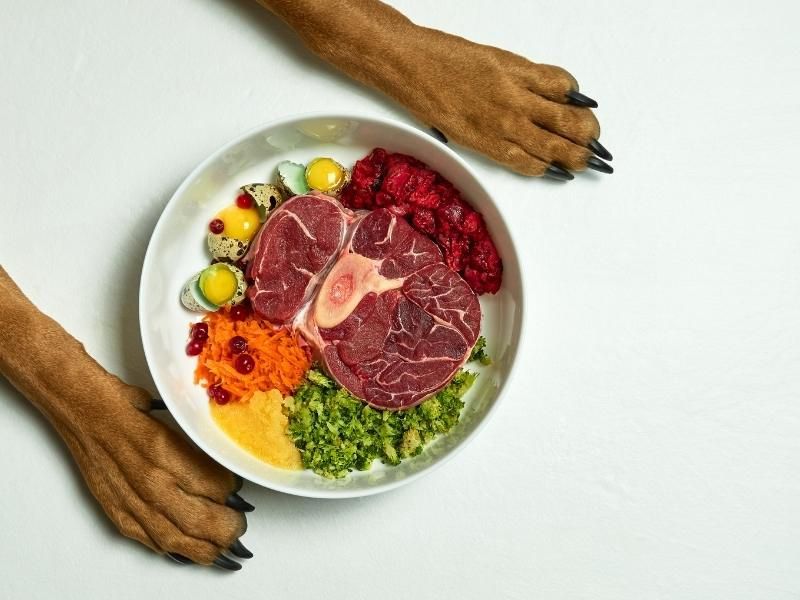
9. Try Different Preparations
Just like humans, dogs may have preferences for certain textures or flavors, so offering vegetables in different preparations can help make them more appealing.
Experiment with cooking methods such as steaming, roasting, boiling, or grilling to alter the texture and flavor of the vegetables. Some dogs may prefer the crunchiness of raw vegetables, while others may enjoy the softer texture of cooked vegetables.
Try adding herbs, spices, or low-sodium broths to vegetables to enhance their flavor and aroma. Be mindful of any ingredients that may be harmful to dogs, such as onions or garlic, and opt for dog-safe seasonings instead.
Present the vegetables to your dog in various forms, such as whole, chopped, mashed, or pureed, to see which they prefer. You can also mix vegetables into their regular food or offer them as snacks.
10. Offer as Treats
11. Make it Fun
12. Hide the Vegetables in Their Food
By hiding vegetables within their food, you can sneak in extra nutrients without your dog even realizing they’re eating their greens.
Cook dog save vegetables until they are soft and tender, then mash, puree, or finely chop them to create a smooth texture or use a food processor to create a vegetable paste that can be mixed into your dog’s food.
Mix the mashed or pureed vegetables into your dog’s regular food, ensuring that they are evenly distributed throughout. You can also layer the vegetables between layers of their food or hide them inside treats or toys for an added element of surprise.
Be creative and experiment with different combinations of vegetables and textures to keep mealtime exciting for your dog. Consider adding small amounts of low-sodium broth or gravy to enhance the flavor and make the vegetables more enticing.
Monitor your dog’s reaction to the hidden vegetables and adjust the amount or preparation method as needed. Some dogs may be more sensitive to changes in their food, so introduce new ingredients gradually to avoid digestive upset.
13. Bribe Them (Last Resort…)
While bribery should be used sparingly and as a last resort, offering high-value rewards can sometimes encourage reluctant dogs to give vegetables a try.
Choose a high-value reward that your dog finds irresistible, such as small pieces of cooked chicken, cheese, or their favorite treats. These rewards should be reserved exclusively for vegetable-eating sessions to maintain their appeal.
Present the vegetables to your dog along with the high-value reward, using positive reinforcement and encouragement to motivate them to eat the vegetables. You can offer the reward immediately after they take a bite of the vegetables to reinforce the desired behavior.
Be cautious not to rely too heavily on bribery, as it may lead to your dog refusing to eat vegetables without a reward. Instead, use this strategy sparingly and gradually reduce the frequency of rewards as your dog becomes more accustomed to eating vegetables on their own.
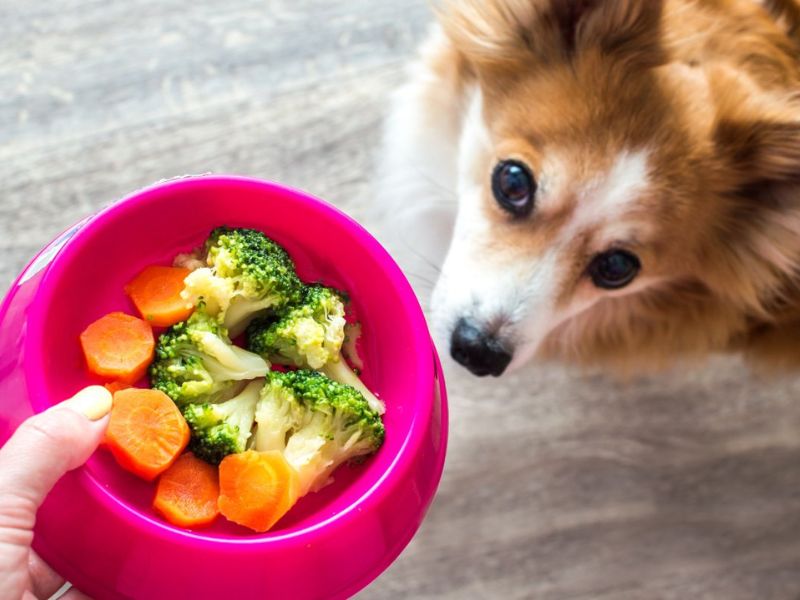
Why Don’t Dogs Like Vegetables?
Dogs’ reluctance towards vegetables can be attributed to their evolutionary history and dietary preferences. Dogs are descendants of carnivores, and their ancestors primarily consumed meat in the wild. As a result, dogs have inherited a preference for meat-based diets, which are rich in protein and other essential nutrients necessary for their health.
Besides, dogs have a different digestive system compared to humans. Their digestive tracts are shorter, and they lack certain enzymes that are required to break down plant matter efficiently. This makes it challenging for dogs to extract nutrients from vegetables compared to meat.
Furthermore, dogs rely heavily on their sense of smell and taste to determine the palatability of food. Many vegetables have a bitter or earthy taste that may not be appealing to dogs, especially when compared to the savory flavors of meat.
However, it’s essential to recognize that individual dogs may have varying preferences towards vegetables. Some dogs may enjoy certain vegetables, while others may be more resistant to trying new foods. With patience, creativity, and persistence, it’s possible to encourage dogs to accept and even enjoy vegetables as part of their diet through positive reinforcement and gradual exposure.
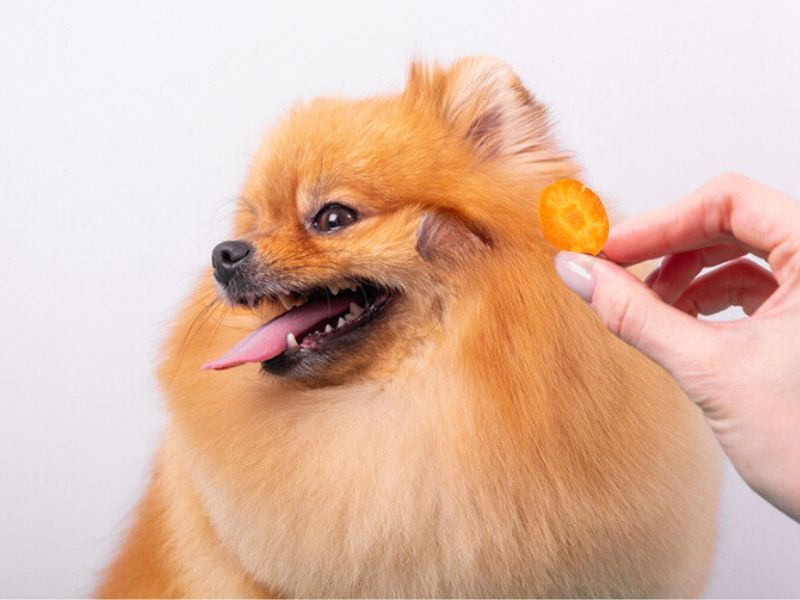
While some varieties of mushrooms are safe for dogs, others can be toxic and cause symptoms ranging from gastrointestinal upset to organ failure. It’s best to avoid feeding mushrooms to dogs unless you’re certain they’re safe.
Certain varieties of wild mushrooms can be toxic to dogs and may cause symptoms ranging from gastrointestinal upset to organ failure. It’s best to avoid feeding mushrooms to dogs altogether.
Are Vegetables Good For Dogs?
Yes, of course. Vegetables can be beneficial additions to a dog’s diet when offered in moderation and as part of a balanced nutrition plan. While dogs are primarily carnivores, incorporating vegetables can provide essential vitamins, minerals, and fiber that contribute to overall health. Vegetables such as carrots, green beans, and sweet potatoes are rich in nutrients like vitamin A, vitamin C, potassium, and fiber, which support various bodily functions, including immune health, digestion, and skin health.
Vegetables also can aid in weight management by adding bulk to meals without excess calories, promoting a feeling of fullness. Some vegetables also have a high water content, contributing to hydration, while crunchy options can help maintain dental health by reducing plaque buildup.
Though dogs can eat certain vegetables, it’s important to know which vegetables that are safe for Pomeranians to consume and in what quantities, because some of them can be dangerous for your dog such as onions and garlic. Vegetables should be prepared in a way that makes them easy for dogs to digest, such as cooking, pureeing, or finely chopping them.
It’s essential to remember that dogs have different nutritional needs than humans and though vegetables can complement a dog’s diet, they should not replace essential nutrients provided by a complete and balanced dog food.
However, you need to identify the vegetables your dog enjoys the most, and that can take time considering just how many different vegetables exist. Some are seasonal so it’s wise to have substitutes for vegetables not currently growing.
Always wash vegetables before feeding it to your beloved Pomeranian to ensure complete cleanliness and make sure to remove seeds, thick skins or peels to reduce the chances of choking. In general, treats (including vegetables) should make up no more than 10% of a dog’s diet.
NOTE: Always check with your veterinarian first before giving your dog any new foods, especially “people foods.” What might be OK for one dog might not be good for your dog, depending on multiple factors, such as their age, health history, health conditions, and diet. Dogs on prescription diets should not be fed any food or treats outside the diet.
Remember, any changes in diet should be made incrementally and gradually. You should always consult a nutrition-focused veterinarian or animal nutritionist before changing your dog’s diet, or if you think your dog doesn’t currently have a balanced and nutritious diet.
Vegetables Dogs Should NOT Eat
Several vegetables are not safe for dogs and can be harmful to their health if ingested or eaten too much. Some vegetables contain compounds that are toxic to dogs, while others may pose a choking hazard or cause digestive upset.
Some vegetables that are dangerous for dogs such as onion, garlic, mushrooms, tomatoes.
You can check complete list of fruits and vegetables that can and can’t be eaten by your dog in “Can My Pomeranian Eat That? A Guide to Safe and Dangerous Fruits and Vegetables“
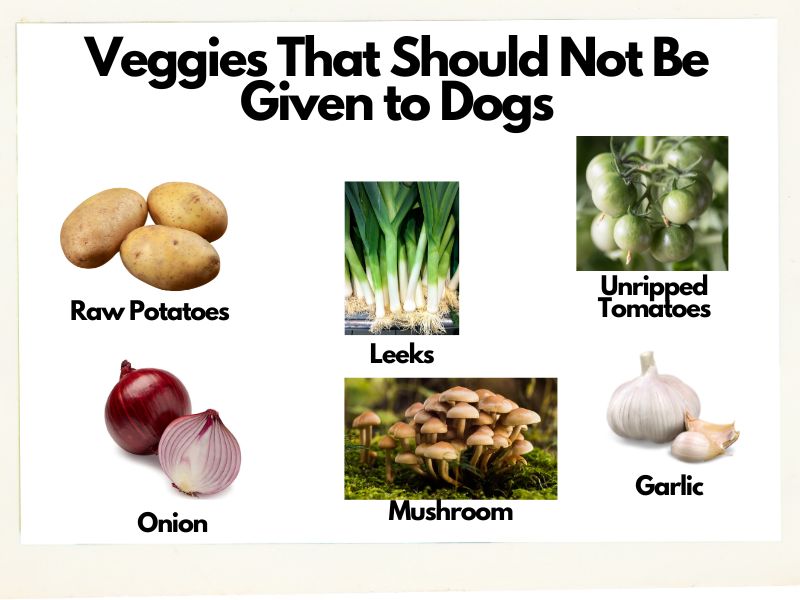
Common Vegetables Dogs Should Avoid
Onions and Garlic
Onions and garlic contain compounds that can damage dog’s red blood cells, leading to anemia. Even in small amounts, these vegetables can be toxic to dogs.
These vegetables, whether raw, cooked, or in powdered form, contain compounds that can damage a dog’s red blood cells, leading to anemia. Even small amounts can be toxic.
Mushrooms
While some varieties of mushrooms are safe for dogs, others can be toxic and cause symptoms ranging from gastrointestinal upset to organ failure. It’s best to avoid feeding mushrooms to dogs unless you’re certain they’re safe.
Raw Potatoes
Rhubarb
Tomatoes
While ripe tomatoes are generally safe for dogs in small amounts, green tomatoes and tomato plants contain solanine and other toxic compounds. These parts of the tomato can be harmful if ingested in large quantities.
Unripened tomatoes, along with the stems and leaves of the tomato plant, contain a toxic compound called solanine, that can cause gastrointestinal upset and other symptoms such as vomiting, diarrhea, lethargy, and weakness in dogs if ingested in large quantities.
It’s essential to keep these vegetables out of reach of dogs and avoid feeding them as treats or part of their regular diet. If you suspect your dog has ingested any of these vegetables or is showing signs of poisoning, contact your veterinarian immediately for advice and treatment.
Raw vs Cooked Vegetables for Dogs
Digestibility
Nutrient Availability
Texture and Palatability
Safety Concerns
Fiber Content
4 Benefits of Raw Vegetables for Dogs
Nutrient Retention
Hydration
Dental Health
Weight Management
4 Benefits of Cooked Vegetables for Dogs
Improved Digestibility
Increased Nutrient Availability
Enhanced Palatability
Safety Concerns Addressed
Is a Vegetable-Only Diet Bad for My Dog?
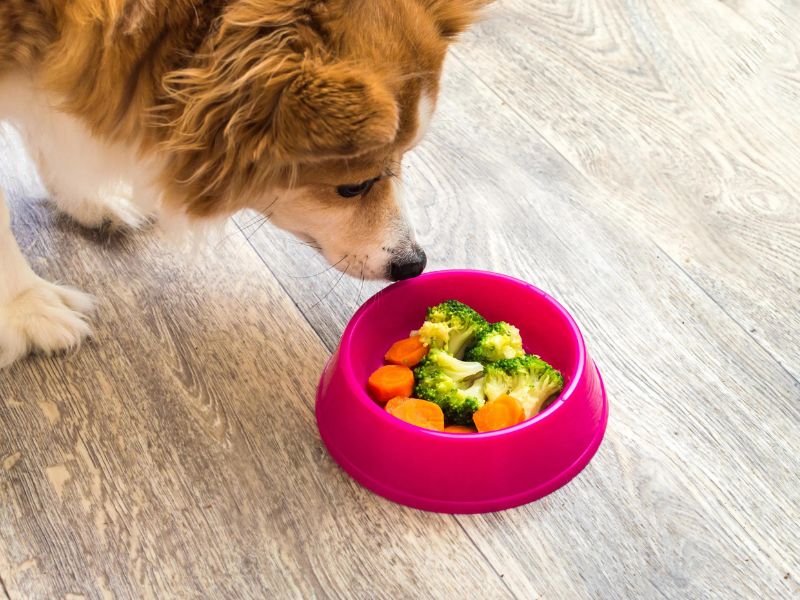
A vegetable-only diet is not recommended for dogs. While vegetables can be a nutritious addition to a dog’s diet, they do not provide all the essential nutrients that dogs need to thrive. Dogs are omnivores by nature, meaning they require a balanced diet that includes a combination of proteins, fats, carbohydrates, vitamins, and minerals to support their health and well-being.
Vegetables lack certain nutrients that are crucial for dogs, such as complete proteins, essential fatty acids, and specific vitamins and minerals like vitamin D, calcium, and taurine. Without these nutrients, dogs may develop nutritional deficiencies that can lead to health problems such as muscle weakness, poor coat quality, immune system dysfunction, and developmental issues, among others.
Dogs have specific dietary requirements that differ from humans, and relying solely on vegetables may not meet these requirements adequately. While vegetables can contribute valuable vitamins, minerals, and fiber to a dog’s diet, they should be complemented with animal-based proteins from sources like meat, fish, eggs, or high-quality commercial dog food to ensure balanced nutrition.
It’s essential to consult with a veterinarian to develop a balanced and nutritious diet plan tailored to your dog’s specific needs, taking into account factors such as age, breed, size, activity level, and any underlying health conditions. A veterinarian can provide guidance on incorporating vegetables into your dog’s diet appropriately and ensuring they receive all the essential nutrients they need to thrive.
Wrapping Up Ways To Get Dogs To Eat Their Veg!
Incorporating vegetables into your dog’s diet doesn’t have to be a daunting task. By utilizing simple and creative strategies, you can make it easy and enjoyable for your canine companion to enjoy the nutritional benefits of these wholesome foods.
Whether you’re mixing vegetables into their favorite meals, or using them as tasty treats, there are countless ways to introduce veggies into your dog’s routine. Remember to choose dog-safe options and avoid harmful ingredients such as onions and garlic.
By gradually introducing a variety of vegetables, you can discover which ones your dog enjoys most and tailor their diet to meet their individual preferences and nutritional needs. Be patient and persistent, as it may take time for your dog to develop a taste for certain foods.
Consider the importance of moderation and balance in your dog’s diet. While vegetables can provide valuable vitamins, minerals, and fiber, they should complement a well-rounded diet that includes proteins, fats, and carbohydrates from other sources.
Consult with your veterinarian to ensure that you’re providing a balanced and nutritious diet for your dog, taking into account factors such as age, breed, size, and any underlying health conditions. A veterinarian can offer personalized recommendations and guidance to help you make informed decisions about your dog’s nutrition.


